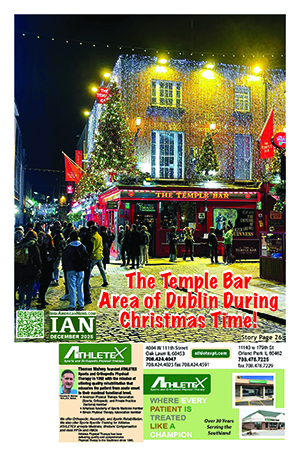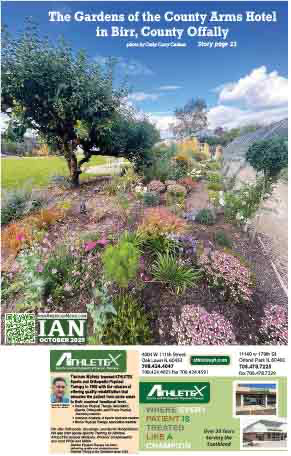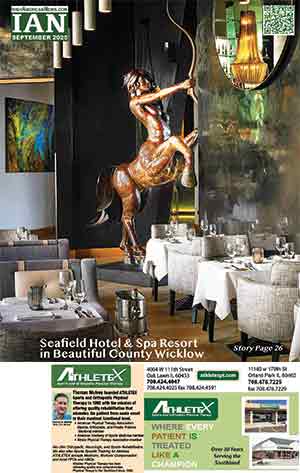By Amanda Slattery,
Development Manager, Ballyhoura Development CLG
More on Foynes in County Limerick
In this months article From Midwest to Midwest, we are connecting the green dots by telling you a little story about the area that your Limerick ancestors came from, and to reach out to you to see if you can help us locate their decendants.
Between 1823 and 1825, over 2,500 people left Ballyhoura Mountain region as part ofan assisted migration programme for Irish tenants from County Limerick and region to relocate to Canada.
This Peter Robinson scheme became know as The Peter Robinson Assisted Emigration Programme and the Ireland Canada Homecoming to the Ballyhoura Region 2025- A Forgotten Emigrant Tale.
For many of us, we associate mass Emigration from the island with the Irish Famine of 1840, and whilst true it is rare to uncover a story of planned emigration such as that of the Peter Robinson Settler scheme, one that took place 20 years previously. Rare that a story in those intervening years could be forgotten here in Ireland, but for a few historians who remembered. In parallel these historic ties have formed the very cultural roots of thousands of descendants in communities across Canada, and now two hundred years on, Ballyhoura Development with communities across North Cork and East Limerick remember them and the resilience of these young families to establish lives anew on the other side of the Atlantic.
The Peter Robinson assisted emigration scheme was one of many such schemes during the nineteenth century, where emigrants from Ireland to overseas were ‘assisted’ with funding and supplies to set up life in a new country.
It has been estimated that as many as 300,000 emigrants availed of such schemes.
In this instance, the scheme was funded by the British Government and under the direction of its employee, Peter Robinson, involved a total of eleven ships taking emigrants from the Port of Cove (Cobh) to the Ottawa Valley and Ontario, Canada in the years 1823 and 1825.
In total 2,500 people comprising 500 nuclear families departed, the vast majority to Ontario departed under “recommendation” from local landlords. It was in 2013, as a legacy of the Gathering, that local volunteers with support from Ballyhoura Development started to explore this piece of our forgotten history.
Why did this occur? The stimulus for this scheme came from a number of factors. The depression following the end of the Napoleonic Wars in 1815 saw the agricultural economy falter while at the same time the introduction of the Corn Laws that same year kept food prices artificially high. Both factors operated against a background of a steep rise in population assisted by the new ‘super-food’, the potato.
The Tithe Composition Act of 1823 added further pressure to the peasant farming community as the obligatory tithe payments from farmers to the Protestant Church were linked to the Corn Laws and so kept high.
The most common occupation listed for emigrants in the Robinson scheme was the term ‘reduced farmer’, a term which seems to mean a farmer forced off the land by low prices for agricultural produce and high landlord rents.
Robinson was specifically instructed to target the ‘disturbed baronies’ of North Cork, that is, places where agrarian outrages and lawlessness among the rural peasantry were common. Most of the emigrants were farmers, reduced or otherwise, the remainder being made up of labourers and tradesmen.
All were required to be ‘paupers’, that is, having no means of their own.
The majority of emigrants hailed from northern Co. Cork and southeastern Limerick, but there were others from Tipperary, Kerry and Clare, as well as one from Wicklow and another from Kilkenny.
The uptake? Robinson established “recruitment centres” across North Cork including Charleville, Mitchelstown and Doneraile within the Ballyhoura area and all villages and rural areas within those circles or a 15mile radius. Conditions were set as to the “selection” process which included no one older than 45, thus families tended to be young with many small children undertaking the journey, which some did not survive. In fact the births on the 6 week voyage balanced the deaths on board. The response to the recruitment in 1825 was 50,000 requests for approx. 2,500 spaces indicating just how dire the circumstances were at this time.
Ballyhoura Development in the intervening years has identified many of the families who left the region 200 years ago to Ontario and Ottawa in Canada. Many descendants finding us and sharing their family’s history. We know so much from this time due to the records of the scheme maintained by Peter Robinson. These show that there was a total of nearly five hundred distinct nuclear families and unattached adults in the scheme, the great bulk being families with two parents and their children.
The records of the scheme list the passengers on each ship under family headings and give ages, occupations and former residences. There is also a ‘remarks’ column where each supporting landlord is named, and where in many cases comments are recorded on the disposition of the adults, deaths occurring during the voyage, and other comments, written by Robinson.
On April 2nd 1824 Robinson writes to Lord Bathurst “During the voyage nothing happened of importance; the rations were abundant and comfortable; the men were allowed cocoa for breakfast, and nearly half a pint of spirits, which was, perhaps, not too much. The women and children were allowed tea and sugar. The best proof of the attention paid to them on the voyage, arises from the good health which they enjoyed, as only one woman and eight children died on the passage, and these from the small pox, which had unfortunately got into both ships, and not from any causes that could be attributed to their change of circumstances or situation.
It may be worth remarking, as it is so characteristic of the fondness of the Irish people for potatoes, that the men preferred them to cocoa, which they refused for several days to taste, till they saw the officers of the ship repeatedly breakfasting upon it. The children during sickness called constantly for potatoes, refusing arrow or root or any other ailments more congenial to their situation; and nothing could prevail on man, woman or child to eat plum pudding, which as is usual on ship board was part of the Sunday’s dinner.
Few of them would eat the best English cheese; and when it was served out as part of their ration, it was most commonly thrown overboard”
Collaborating with the communities in Peterborough that the settlers went on to call home, we have planned commemoration events in the origin communities in Ballyhoura and the settler communities in Canada, this 200th year.
Family names associated with the emigration include:
Armstrong, Carty, Jessup, Dimond, Dillon, Leahy from Kilfinane, Co. Limerick
Rourke, Shouldess (Shouldice), Fitzgerald, Newcastlewest, Co. Limerick
Young, O Brien, McCarroll, Mullane, Cunningham from Adare, Co. Limerick
Dulmage, McCarthy, Grogan, Lowes, Rahilly from Rathkeale, Co. Limerick
Collins, from Askeaton ; Blackwell from Kilkeedy, Boate from St Michaels Limerick
Buckley, Dahill, Maddigan from Colmanswell, Co. Limerick
Kennelly, Leary, Quin from Kilbehenny, Co. Limerick
Barry, Coghlan, Connery, Daly, Egan, Healy, Keeffe, Linehan, Lingnan, Haly, McCarthy, McCoy, McDonald, Miles, Nelligan, Ray, Roche, Stack, Sullivan, Shea, Walsh from Doneraile, Co. Cork
Benson, Buckley, Dowlin, Fitzgerald, Hamilton, Houlahan, Jessup, Kennedy, Lee, Mann, Meany, Riordan, Roche, Russell, Swytzer from Charleville, Co. Cork
Barry, Buckley, Brien, Clahan, Daherty, Downy, Hartnett, Lynch, McAuliffe, Murphy, Pigot, Power, Purcell, Regan, Sheehan, Sullivan from Churchtown, Co. Cork
Brestnahan, Donahoe, Fitzgerald, Guinea, Lyne, Leary, McConnell, Ormsby, Shehan, Sheneck from Liscarroll, Co. Cork
Armstrong, Condon, Couche, Cronan, Hegarty, Hickey, Keiffe, Leahy, Mansell, O’Brien, Ryan, Scanlin, Slattery, Smithwick, Thomhill, Torpy, Toughal, Wall, Andrews, Byrne, Callaghan, Condon, Cotter, Doherty/O’Doherty, Elligott, Fyn, Keane, Mason, McCarthy, Meade, Mulloany, O’Brien, O’Donnell, Roche, Sargent, Sullivan, Tobin, Walsh from Mitchelstown, Co. Cork.
Within these families there is a rich story of why they left and of the lives they went onto live as we look ahead to our homecoming week. We know that it will be a week to remember for all that are linked to the families and bring a forgotten emigrant story back into living memory.
The Ireland Canada Homecoming “Remembering the Peter Robinson Settlers of the Ballyhoura Region- 200th Anniversary is a week long event planned for September 15th -21st 2025 and will see descendants worldwide, predominantly from Canada and the US come to the area, to take part in visits to the origin communities, planned itineraries in and outside of the region to communities of interest, meeting local people, taking part in a commemoration concert and conference and will culminate in a very special memorial for descendants that come back home. A special wreath laying ceremony will take place on May 9th 2025 to mark 200 years since the May sailings of 1825 with descendants and local communities at the point of departure in Cobh, Co. Cork.
https://www.ballyhouradevelopment.com/peter-robinson-settlers-homecoming-2025
If you believe you are a Peter Robinson settler descendant and want to find out more reach out to us Amanda Slattery Ballyhoura Development CLG 
Captain Charles Blair and his wife, Maureen O’Hara
More on Foynes
By Sean Liston, Archivist, Limerick
In a new monthly article From Midwest to Midwest, we are connecting the green dots by telling you a little story about the area that your Limerick ancestors came from.
This month we start in Foynes, County Limerick. One of the many stops on the Shannon Estuary Way, a new 207km-long loop drive taking in Clare, Limerick and Kerry, Foynes is a village in County Limerick in the south west of Ireland. It is situated on the south bank of the Shannon river where the estuary begins to widen out as it approaches the Atlantic ocean.
The earliest logboat found in the estuary at Carrigdirty near Askeaton was dated from c. 5800 years ago.
St. Patrick is reputed to have visited the area in the 5th Century and to have blessed the country westwards from nearby Knockpatrick. Through the centuries, local kingdoms, invading Vikings and Normans have held sway over the local countryside.
Connecting the Green Dots in FOYNES
If your family came from this area read on because these are the things that they might have been involved in.
The Port and Railway
Foynes was surveyed in the 1830s by the Royal Navy with a view to establishing a port where deep water facilities were available. From a modest pier with railway connection to the rest of Ireland in the 1850s a thriving port has grown. Foynes was the last port of call of the Evelyn which brought uniforms from the Limerick Clothing Factory to the Confederate Army during the American Civil War.
The Sawmills
Originally The Monteagle Mill, timber was purchased from Russia and Scandinavia during the 19th Century. Huge ships from these countries used Foynes port and the sawmills were a busy place to work.
Cooperative Creamery
and Poultry Societies
Some of the first agricultural cooperatives in the country were set up in and around Foynes from 1889. These progressive and successful societies gave local farmers security and, although they have changed over the years, the global giants like Kerry are founded on the history of small farmers from this region.
The GAA
In 1925 Foynes captured a county Junior Football title and in 1933, Shanagolden and Foynes contested the West Junior final with Shanagolden emerging winners 1-5 to 1-4. Then in 1936, Foynes reached the county Senior Football final but were defeated 0-7 to 0-3 by Ahane who were led by the legendary Mick Mackey.
From 1939, WW2, The Emergency and economic hardships forced many to emmigrate. The decision was taken to join the local clubs under the one banner. In the spring of 1947, a public meeting was convened in Foynes and after much debate and discussion a new club came into existence and St. Senans GAA club was formed.
The Centre of the Aviation World from 1939 to 1945
A later survey overseen by aviation pioneer Captain Charles Lindberg led to the choice of Foynes Harbour with its sheltered waters as a base for the Transatlantic Flying Boat service during the Second World War. This was operated by Pan American Airlines, BOAC and American Export Airlines. Passengers often enjoyed an Irish Coffee that was created in 1943 by Chef Joe Sheridan in the Airport Terminal formally known as the Monteagle Arms Hotel.
A SELECTION OF CELEBRATED VISITORS TO FOYNES 1939–1945
In February 1944, actor and decorated naval officer, Douglas Fairbanks passed through Foynes followed by Prime Minister of Australia, John Curtin and novelist Ernest Hemingway in May. Also in 1944, Polish Prime Minister Mikolajczjk in June, Czechoslovak Minister Jan Masaryk and New Zealand Prime Minister P. Frazer transited through Foynes.
Everyone that was anyone flew through Foynes during those years including from the world of politics, John F. Kennedy, Mrs. Eleanor Roosevelt, Anthony Eden (Foreign and Dominions Secretary), Lord Keynes (Maynard) (Economist, British Treasury), A. P. Herbert (British Minister) and Lord Louis Mountbatten.
Royalty included Prince Ibn Saud (Saudi Arabia), Charlotte, Duchess of Luxembourg, Queen Wilhelmina of Holland, King George of Greece, Olaf Crown Prince of Norway and Prince Bernhard of Holland. People from the world of entertainment included actor and comedian Bob Hope, actors Merle Oberon, Gracie Fields, Bill Rogers, Edward G. Robinson and Humphrey Bogart, and musician Yehudi Menuhin.
The last scheduled North Atlantic flight from Foynes to New York in October 1945 was piloted by Captain Charles Blair, husband of screen legend Maureen O’Hara who later donated her Hollywood Oscar and an extensive wardrobe to the Foynes Flying Boat Museum where they and the story of the Flying Boat era can be viewed today.
Fuel
The BP terminal was an important business in Foynes; fuelling for example the Short flying boat, Caledonia, which completed the 1,900 mile flight across the Atlantic from Foynes to Newfoundland in 1937.
Modern Foynes
Foynes is one of Irelands leading bulk ports and has received recognition from the European Union as one of the three Tier One ports of Ireland. The port has been considerably developed by the former Foynes Harbour Trustees and its successor, Shannon Foynes Port Company. Foynes is busy with cargo and cruise ship traffic and as a base for Ireland’s expanding marine energy sector.





















